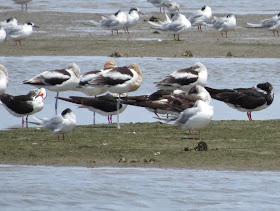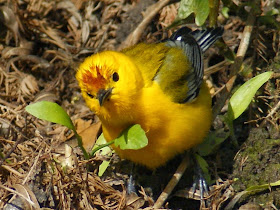After Anahuac we drove down to High Island, just in time to join the noon birdwalk led by the great guides from Tropical Birding. Well, it wasn't really a "walk" - we drove down to two sites on Bolivar and did some stationary birdwatching at each one.
First up was Rollover Pass. As usual, the sandbars and shallows had thousands of birds ranging from Brown Pelicans to Western Sandpipers, and including six Tern and four Plover species. This particular day wasn't ideal for photography because many of the birds were at a distance and the wind was too strong to allow telephoto shots without a tripod. Another problem was that many of the birds were sleeping, with their heads tucked back into their feathers.
Luckily, some birds were awake, like these Royal Terns.
And these American Avocets (the lefthand one in breeding plumage) and Black Skimmer.
A few birds even wandered along the edge of the beach, like this American Avocet (unfortunately not in breeding plumage) and Marbled Godwit.
Another Marbled Godwit was managing to explore the beach in spite of having a broken leg.
From Rollover Pass we drove a few miles to Barbados Drive, where we got distance looks at a Long-billed Curlew, some American Golden Plovers and two Upland Sandpipers.
Then it was back to Boy Scout Woods for lunch. There were a few migrants: Blue-headed Vireo, White-eyed Vireo, Yellow-throated Vireo, Black-and-white Warbler, Northern Parula and Hooded Warbler. However, only a Louisiana at Purkey's Pond stayed in view long enough for a recognizable photo.
Rather disappointed by the lack of warblers, we went up to look at the rookery in Smith Oaks. As should be clear from the photos I've already posted, the rookery was very busy with Great Egrets and Roseate Spoonbills. Although it is still early in the nesting season, a couple of Great Egret nests contained eggs.
Walking back past Smith Pond, I noticed that Roseate Spoonbills, Black-necked Stilts and Blue-winged Teal were feeding dangerously near a couple of alligators.
Just as we were ready to leave High Island, I decided to have a quick last look at Purkey's Pond, just in case. I'm really glad I did!
Almost immediately after I got there, a White-eyed Vireo popped up in a bush only a few yards away.
Then I got one of those sightings that happen only very rarely.
Two beautiful Prothonotary Warblers appeared. One stayed well back from the path but was still clearly visible.
The other came nearer.
And nearer.
And nearer.
It ended up wandering around on the ground less than ten feet from where half-a-dozen of us were standing spellbound. What a sight!
BTW, I was surprised to see that this bird had a patch of red feathers on its forehead, as this is a feature that I have never seen mentioned in book or website descriptions of male Prothonotary Warblers. I assume the patch represented staining from some kind of fruit.
Although this trip wasn't as productive as some previous spring visits to Anahuac, High Island and Bolivar, four hours of birding added 20 species to my 2014 list. Besides, I'd have happily driven there and back just to see that Prothonotary Warbler.
.


















Jeff. I enjoyed reviewing your recent posts which brought back some happy memories of a similar trip some years ago.
ReplyDeleteI can understand your joy of seeing the Prothonotary ... super close ups.
Wonderful Warbler, I share your excitement Jeff, its a stonker of a bird, great great images.
ReplyDelete